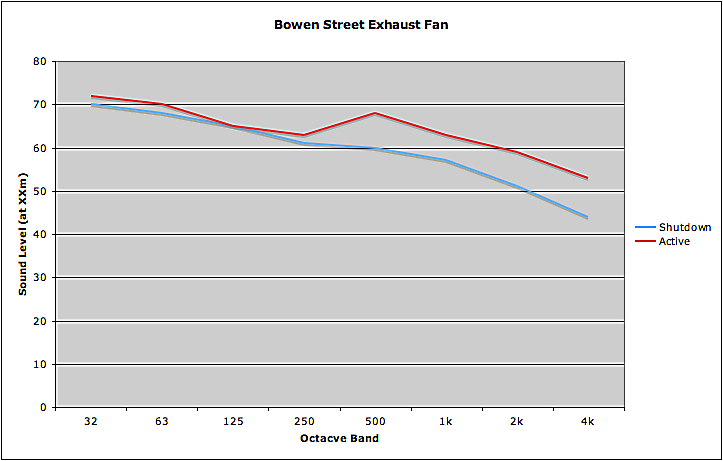Shutdown
Prior to the interventions, a shutdown of the exhaust fan was arranged. This enabled students to gain a sense of the impact the noise source has on the site when it is running. Recordings of the site were taken during the shutdown, which students also experienced in real-time. Having been taught to listen actively through various acoustic ecology exercises, the students were amazed at how instantly humanized the space became upon the noise’s subtraction. A market was active during the shutdown, and voices that had been experienced as unintelligible murmurs suddenly became clear and coherent.
A spectogram of the soundscape was generated during shutdown. It became an important point of discussion for the class, as its visual representation perfectly matched the experience of being on the site during the shutdown (see figure 2). The spectogram clearly shows, in the middle of the image, the moment when the exhaust fan was switched off. The absence of the “fog” to the right of the image provides an excellent visual representation of the noise source’s absence. Fog is a fitting analogy for acoustic ecology’s description of a lo-fi soundscape in that the environment is reduced to a homogenous sonic experience, in which existent sounds become indistinguishable; just as the individual elements of a landscape become more distinguishable when fog lifts, the various elements of a soundscape are heard more clearly when a noise source is removed.[2]
The spectogram provided an imaginative stimulus – the shutdown being equivalent with the removal of a “dominating voice” – but it also helped to demonstrate the actual, perceivable, implication of specific CRESSON sound effects. The analysis emphasized the drone, mask, and filtration sound effects (see above), which assisted students in identifying analytical approaches to their interventions. The drone was identifiable in the horizontal broadband pattern in the lower section to the left of the image; masking was depicted in terms of the fog analogy; and, on-site, it was clear the metal awning was adding a filtration effect to the sound volume. The filtration effect was further emphasized with 1/3 band octave sound level measurements at the site both before and after the shutdown. After the shutdown, a significant decrease in the volume of frequencies above 200Hz could be identified (see figure 3). It is interesting to note that the most sensitive range of human hearing (approximately 1-4kHz) was positively impacted by the shutdown, creating acoustic conditions that enabled clearer communication. It is tempting to connect this beneficial change to the listening environment with the almost instant emergence of human voices (represented by the dark vertical lines to the right of Figure 2), though of course a more detailed study would be required to make such an assertion.
Figure 2: Spectogram of Exhaust Outlet Shutdown (generated with Audiosculpt[3]). In this rescaled version of the original spectrogram, the y-axis is approximately 4kHz and the x-axis is approximately 30s. The darkest broadband frequencies at the bottom of the image range from 150-500Hz. The vertical lines represent human voice formants.

